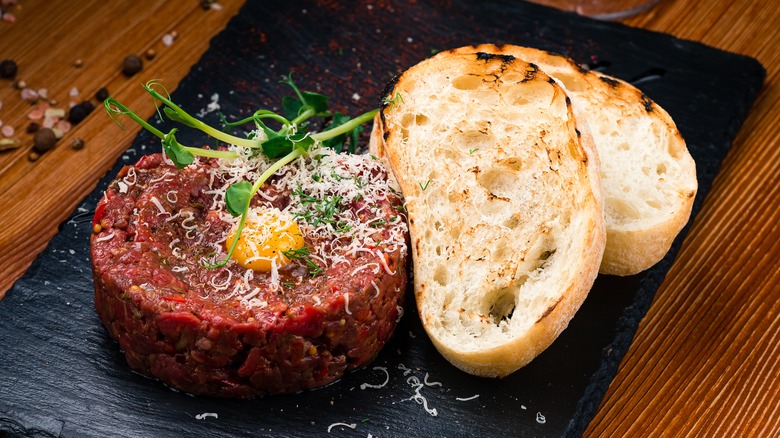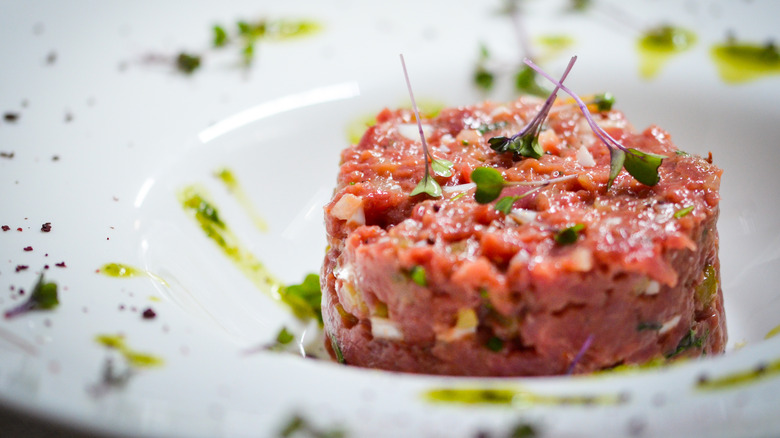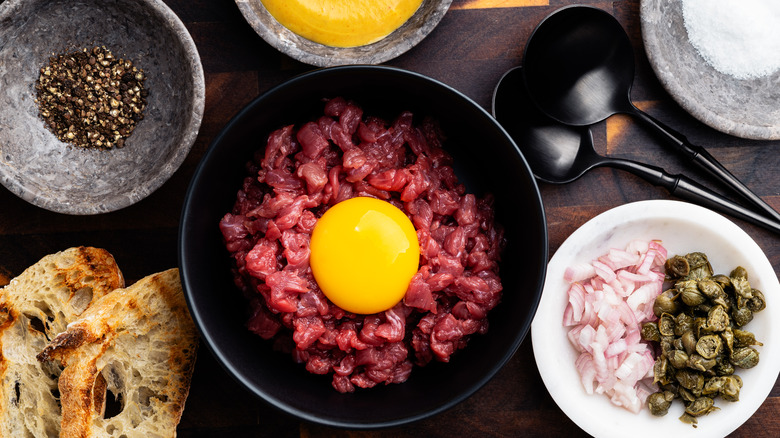Steak Tartare Started Off As The Food Of Warriors
We may receive a commission on purchases made from links.
Since eating raw meat might seem like a pretty fearless thing to do, it's perhaps not surprising that one legend surrounding the origins of steak tartare associates it with warriors. Supposedly, so the story goes, Genghis Khan's warriors, the nomadic Tatars, used to place pieces of horsemeat under their saddles before riding off at dawn; by the end of the day, it would be tender enough to eat without being cooked.
However, evidence suggests that this colorful origin story is, in fact, untrue. Any meat the horsemen were stowing under their saddles was likely destined for purposes other than dinner, such as the healing of equine sores. Whether the meat for tartare was originally horse rather than beef is also up for debate – though the French culinary bible "Larousse Gastronomique" does state that the dish is made with ground beef "or horse meat, according to the purists."
Rather than the sweaty saddle meat story, it's more likely that steak tartare is so named because a version of the dish used to be served with tartar sauce. The French description, à la tartare, originally referred to grilled dishes covered in breadcrumbs and served with a rich sauce (per "Larousse Gastronomique"). These days, it tends to refer to either the sauce or to a raw meat dish — though you sometimes see variations such as fish tartare, commonly made with diced raw tuna.
Steak tartare was originally called beefsteack à l'Américaine
Steak tartare is rooted in French cuisine — but the French actually used to refer to the dish as "beefsteack à l'Americaine" (per the Michelin Guide), meaning in the American style. It's not clear why this was the case; perhaps there was an assumption at the time that Americans ate meat uncooked. The dish, served with a raw egg yolk, was popular in the bistros of Paris in the early 1900s.
In the 1920s, renowned French chef Auguste Escoffier wrote a recipe for beefsteack à l'Américaine that was served without an egg but accompanied by tartar sauce instead. Over time, the dish became known as à la tartare when served this way. But it wasn't until the 1950s, when more American tourists began to visit Europe, that the dish became increasingly popular and sought-after — and more like the dish we recognize today.
Steak tartare is not usually served with tartar sauce on the side anymore — though it does often incorporate many of the ingredients that make a good tartar sauce as add-ins. These might include egg yolk, oil, capers, and cornichons, which taste different from dill pickles, are smaller, and less tart.
Modern steak tartare has many different variations
Traditionally, steak tartare consists of finely chopped or minced raw beef served with an uncooked egg yolk nestled on top. Anthony Bourdain's tip for making steak tartare was that the meat should always be chopped by hand rather than using a food processor to retain the best texture and prevent it from becoming mushy. The beef is usually mixed with ingredients such as chopped shallots, Worcestershire, and Tabasco sauces alongside the cornichons and the capers associated with tartar sauce.
As is the case with so many classic dishes, steak tartare continues to evolve as chefs and home cooks alike strive to put their own spin on it. One way to do this is by switching up the add-in ingredients to create new flavor combinations. Fish makes a tasty, umami-packed addition — whether in the form of chopped anchovies, or something a little more complex such as a smoked oyster aioli.
Another way to add a new twist involves the egg yolk. Curing the yolks in soy sauce – with sugar and sake — gives them a robustly rich, savory taste as well as a firmer texture. Alternatively, you can confit the egg yolks by cooking them very gently in oil. For another spin, instead of serving the meat with the traditional bread or french fries, try croutons fried in beef tallow – a great butcher shop find for restaurant-quality steaks and sides. Or spoon the mixture onto tostadas for a crunchy contrast.



